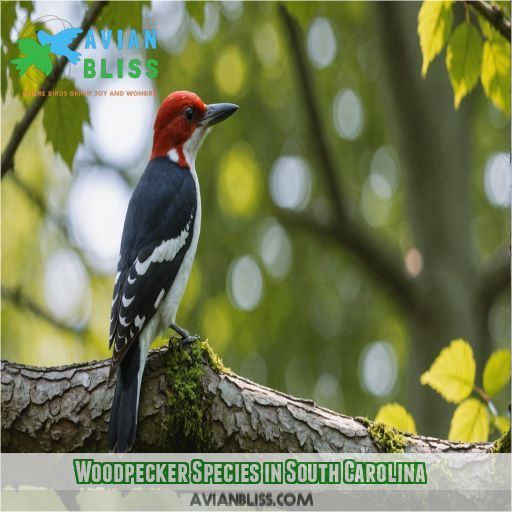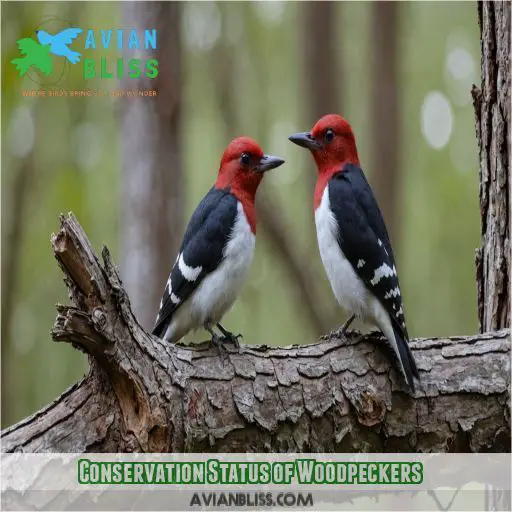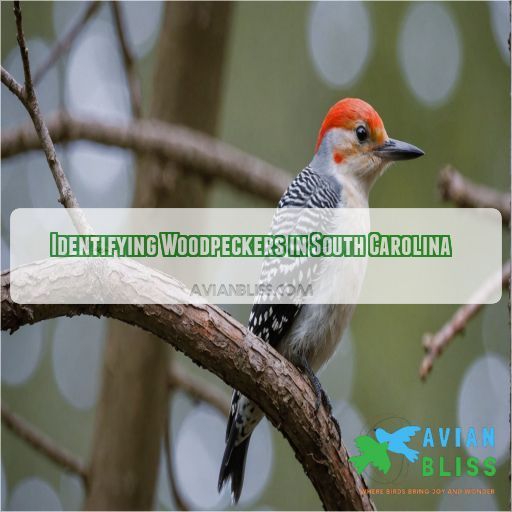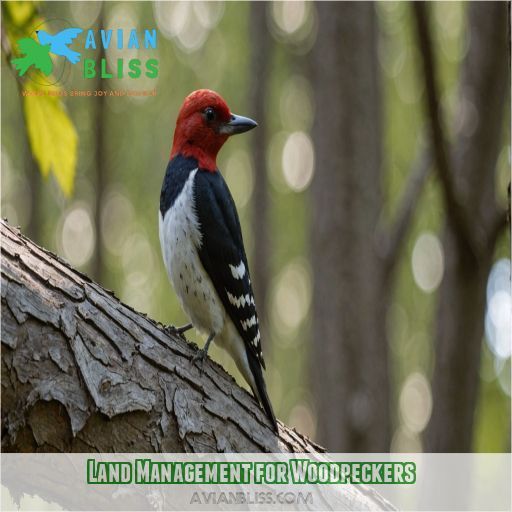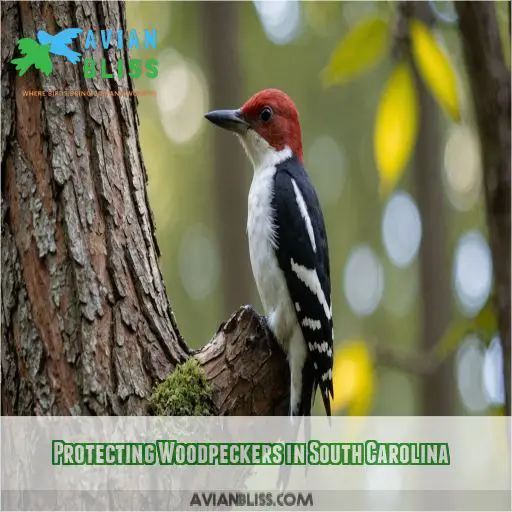This site is supported by our readers. We may earn a commission, at no cost to you, if you purchase through links.
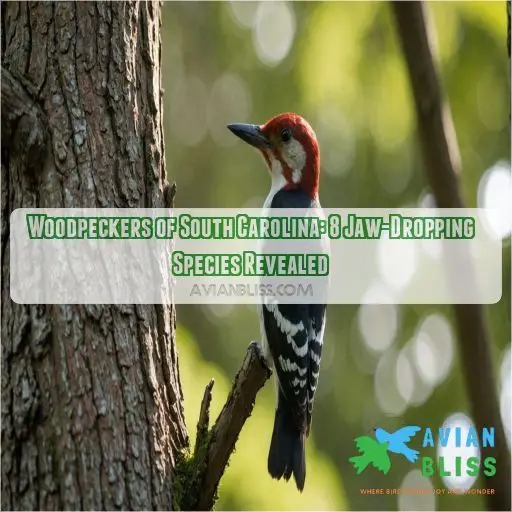
The most common woodpecker in the state is the red-bellied woodpecker, found in various habitats, including woodlands and suburban areas.
Other species include the tiny, energetic downy woodpecker, the medium-sized northern flicker, and the large, striking pileated woodpecker.
These birds sport a mix of black, white, and red feathers, with distinct markings for each species.
Some, like the red-cockaded woodpecker, are endangered and face threats from habitat loss.
Stay tuned to discover more about these fascinating birds and how to identify them.
Table Of Contents
- Key Takeaways
- Woodpecker Species in South Carolina
- Woodpecker Characteristics
- Nesting and Breeding Habits
- Diet and Foraging Patterns
- Conservation Status of Woodpeckers
- Identifying Woodpeckers in South Carolina
- Land Management for Woodpeckers
- Threats to Woodpecker Populations
- Woodpecker Migration and Distribution
- Protecting Woodpeckers in South Carolina
- Frequently Asked Questions (FAQs)
- What is the largest woodpecker in South Carolina?
- What is the difference between a red-cockaded woodpecker and a downy woodpecker?
- How do you identify a woodpecker?
- Are woodpeckers protected in SC?
- What do woodpeckers in SC look like?
- Where do woodpeckers nest and breed?
- What do woodpeckers eat?
- Are woodpeckers in SC endangered?
- How can I ID woodpeckers in my yard?
- Conclusion
Key Takeaways
- If you’re a woodpecker enthusiast in South Carolina, you’re in luck: the state is home to eight remarkable species, each with unique characteristics, habits, and habitats that set them apart from one another.
- Woodpeckers are picky about their homes, and for good reason—they need specific trees for nesting, with some species preferring dead or dying ones. The structure and variety of the forest play a big role in their habitat, so even cities can be good for woodpeckers if planned carefully.
- From the 6.1-inch-tall downy woodpecker to the impressive 17.5-inch-tall pileated woodpecker, these birds are a sight to behold—but sadly, 40% of South Carolina’s woodpecker species are considered endangered or threatened, so conservation efforts are vital to protect these incredible birds and their habitats.
- Whether you’re a seasoned birdwatcher or just starting out, identifying woodpeckers in South Carolina can be a fun challenge—just remember to look for distinctive marks like red caps, black stripes, or white undersides, note their size and beak shape, and observe their behavior to narrow down the species.
Woodpecker Species in South Carolina
You’re in for a treat as you explore South Carolina’s diverse woodpecker population, where eight remarkable species reveal their unique characteristics and behaviors. From the common Red-bellied Woodpecker to the endangered Red-cockaded Woodpecker, each species offers a fascinating glimpse into the lives of these incredible birds.
Red-bellied Woodpecker
You’re in luck if you live in South Carolina, as the Red-bellied Woodpecker is a common sight in woodlands and backyards throughout the state. With their striking red caps and black-and-white striped backs, they’re hard to miss.
- Habitat Preferences: Woodlands, forests, and suburban areas
- Social Behavior: Monogamous pairs during breeding season
- Food Sources: Insects, fruits, and sap
- Nesting Sites: Excavated cavities in dead trees
- Visual Identification: Red cap, black-and-white striped back, and white underside
Downy Woodpecker
Now it’s time to talk about the Downy Woodpecker, the smallest yet most widespread woodpecker in South Carolina. Measuring 6.1 inches, these woodpeckers have a black and white striped back and can be identified by a red spot on the male’s head.
| Mating Habits | Foraging Strategies | Social Behavior |
|---|---|---|
| Monogamous pairs | Insect-based diet | Often seen alone |
| Nests in trees | Uses specialized tongue | Can join small groups |
| 2-8 eggs per nest | Forages on shrubs, trees | Known to visit feeders |
| Incubation: 9-14 | Frequent visitor to suet | May store food in tree |
| days by both sexes | feeders, especially in | cavities for later use |
Northern Flicker
You’re about to meet the Northern Flicker, a medium-sized woodpecker with a penchant for ants and a flair for the dramatic. With its distinctive "yip" call and striking yellow or red undersides, this bird is a treat to spot. But what makes it tick? Let’s take a closer look:
- Habitat preferences: open woodlands, urban parks, and backyards with trees.
- Distinctive calls: a loud, piercing "yip" or "wicka-wicka".
- Breeding habits: monogamous pairs form during breeding season, with males engaging in drumming displays to attract females.
- Wing patterns: bold black spots on a brown or gray background, with a white rump patch.
Pileated Woodpecker
Meet the Pileated Woodpecker, South Carolina’s largest woodpecker! You’ll recognize its bright red crest and distinctive drumming sounds. These birds require mature forests with large trees for nesting and foraging. They’re skilled excavators, using their powerful beaks to uncover insects and sap. Listen for their loud, chuckling calls, and you might just spot one in action!
Red-headed Woodpecker
You’re probably familiar with the red-headed woodpecker‘s striking crimson head, but did you know it’s one of the most endangered woodpeckers in South Carolina? Habitat destruction and changes in food supply have led to a 70% decline in population over 35 years. Effective conservation efforts are necessary to protect this species and its unique characteristics.
Red-cockaded Woodpecker
Meet the red-cockaded woodpecker, a habitat specialist that’s quite the
Ivory-billed Woodpecker
You’re probably wondering about the Ivory-billed Woodpecker, a mysterious bird with a debated existence. Here are four key things to know:
- Last confirmed sighting: 1944 in Tensas River Valley, Louisiana.
- Ecological role: Played a vital part in maintaining healthy forests by controlling insect populations.
- Extinction debate: Despite reported sightings, its status remains uncertain.
- Conservation efforts: Protected under the Endangered Species Act, but habitat destruction hampers recovery.
Yellow-bellied Sapsucker
Now that we’ve explored the Ivory-billed Woodpecker, let’s talk about the Yellow-bellied Sapsucker.
This woodpecker species creates sapwells in selected trees to feed on sap and insects.
Watch for their unique beak adaptations and foraging behavior.
They migrate to Canada for breeding, so catch them in South Carolina during the winter months.
Their distinctive plumage makes them a treat to spot.
Woodpecker Characteristics
You’re about to meet the fascinating woodpeckers of South Carolina, with their unique combinations of black, white, and red feathers, which set them apart from one another. As you explore the characteristics of these birds, you’ll discover the distinctive plumage patterns, varying sizes, and notable head and facial markings that make each species a standout in the woodpecker world.
Plumage Patterns
As you explore South Carolina’s woodpeckers, notice their stunning plumage patterns. With striking black, white, and red feathers, each species has its unique charm. Males and females often differ in their coloration, with some species displaying bright crimson caps or red patches on their heads. Study these patterns to become a master woodpecker identifier!
Size and Length
When you start looking at woodpeckers, you’ll see they come in all shapes and sizes, especially the eight species found in South Carolina.
The average length ranges from 6.1 inches, like the Downy Woodpecker, to an impressive 17.5 inches for the Pileated Woodpecker.
This variety is a sign of South Carolina’s rich natural resources and diverse wildlife, which we should protect and conserve.
Head and Facial Markings
As you get familiar with South Carolina’s woodpeckers, you’ll notice that head and facial markings are really important for identification. * Color variations can be quite stunning, and you might find yourself captivated by the:
- Red cap of the Pileated Woodpecker
- Black and white stripes of the Hairy Woodpecker
- Tan-gray face of the Red-bellied Woodpecker
Beak Shape and Size
In the world of beak shape and size, woodpeckers are the ultimate pros. Their beaks are specially adapted for foraging and drumming. Let’s take a closer look:
| Species | Beak Shape and Size |
|---|---|
| Downy Woodpecker | Short, pointed beak (about 0.5 inches long) |
| Hairy Woodpecker | Longer, more pointed beak (about 1 inch long) |
| Northern Flicker | Medium-sized beak with a slight curve |
| Pileated Woodpecker | Long, broad beak (about 2 inches long) |
Each beak is a unique masterpiece, shaped by evolutionary pressures and dietary needs. Who knew beaks could be so cool?
Nesting and Breeding Habits
When you’re out spotting woodpeckers in South Carolina, you’re probably wondering where they make their homes – and how they raise their young (Source). It turns out that all the state’s woodpeckers share some common nesting habits, including excavating their own cavities, laying eggs, and taking turns incubating them .
Excavating Nesting Cavities
Woodpeckers in South Carolina are skilled excavators.
As a nesting site selector, it’s interesting to know that these birds choose trees with care. They often opt for pine or other decaying wood.
The hairy woodpecker and yellow-bellied sapsucker take around 2-3 weeks to excavate their nesting cavities. Artificial cavities can save them time and energy.
Egg Laying and Incubation
As you explore the fascinating world of woodpeckers in South Carolina, you’ll discover the intricate process of egg laying and incubation. Female woodpeckers lay 2-10 eggs in a nesting cavity, which both parents take turns incubating for 9-14 days. Here are three interesting facts about woodpecker eggs:
- Eggshells form over 20 days as a protective barrier against environmental stressors .
- Incubation periods vary among woodpecker species, with some lasting up to two weeks .
- The unique structure of woodpecker eggs helps maintain a stable temperature, ensuring the embryo develops properly .
Parental Care and Fledging
You’re now a proud parent – well, not literally, but you’re about to learn about woodpecker parenting!
After hatching, nestlings rely on their parents for food and protection.
Both males and females take turns feeding and caring for their young.
As the chicks grow, parents gradually phase out food provisioning, encouraging fledglings to forage on their own and take flight, usually within 2-5 weeks.
Diet and Foraging Patterns
You’re about to uncover the fascinating world of woodpecker diets, where insects are the main course, and sap is the sweet treat. In this section, you’ll explore the unique foraging patterns of South Carolina’s woodpeckers, from the sapsuckers’ sap-sipping habits to the flickers’ ground-foraging antics.
Insectivorous Diets
As you explore South Carolina’s diverse woodpecker population, you’ll discover their insectivorous diets are quite fascinating. These birds have adapted unique foraging strategies to exploit various food sources. Let’s take a peek at what’s on the menu:
- Beetles and their larvae are a staple in most woodpeckers’ diets
- Ants and their eggs are a tasty treat for many species
- Flies and spiders are also on the menu
- Caterpillars and aphids provide essential nutrients
Sapsuckers and Sap Consumption
Let’s talk sapsuckers. These woodpeckers, specifically the Yellow-bellied Sapsucker, rely heavily on sap, making up a significant portion of their diet . They expertly drill rows of sap wells into tree bark, taking advantage of ideal sap flow patterns (Source). This adaptation is no easy feat, and researchers are taking note, helping us better understand their unique sap-feeding behavior .
Flickers and Ground Foraging
- Ant larvae are their jam: Flickers feed on ant larvae, using their long, sticky tongues to slurp them up.
- Ground vs trees: Unlike other woodpeckers, flickers forage on the ground, searching for tasty insects and seeds.
- Migration masters: Flickers migrate to areas with abundant food, making them expert navigators of foraging habitats.
Conservation Status of Woodpeckers
As you explore the fascinating world of South Carolina’s woodpeckers, you’ll discover that some species are thriving, while others are facing significant threats to their survival. In this section, you’ll learn about the conservation status of these incredible birds, including the endangered red-cockaded woodpecker, and what’s being done to protect their populations and habitats .
Endangered and Threatened Species
Now that you know what woodpeckers eat, let’s talk about the ones that need our help. South Carolina is home to several endangered and threatened woodpecker species, including the Red-cockaded Woodpecker and the Red-headed Woodpecker. Conservation plans are in place to protect their habitats and aid in species recovery. Your support can make a difference in their population decline.
Habitat Loss and Fragmentation
You’re now aware of the endangered and threatened woodpeckers in South Carolina, but what’s causing their decline? Habitat loss and fragmentation are major contributors. Here are some key consequences:
- Forest fragmentation effects: isolated habitats, reduced food sources, and decreased genetic diversity
- Ecosystem disruption: altered species interactions, changed fire regimes, and shifted nutrient cycles
- Land use impacts: urbanization, agriculture, and forestry practices
- Suburban sprawl: human-dominated landscapes, decreased wildlife corridors, and increased woodpecker mortality
Conservation Efforts and Research
You’re enthusiastic to make a difference in the lives of South Carolina’s woodpeckers. Conservation efforts are underway to protect these incredible birds. Researchers are working tirelessly to study and monitor woodpecker populations, habitats, and behaviors.
| Conservation Efforts | Research Focus | Community Impact |
|---|---|---|
| Habitat Restoration | Species Monitoring | Community Engagement |
| Nesting Success | Research Funding | Conservation Collaborations |
| Conservation Networks | Conservation Campaigns | Woodpecker-friendly Habitats |
| Science-based Conservation | Evidence-driven Policy | Woodpecker Conservation |
| Ongoing Research | Adaptive Management | Protecting Woodpeckers |
Identifying Woodpeckers in South Carolina
As you explore the woodpeckers of South Carolina, you’ll quickly discover that identifying these amazing birds requires attention to detail and a little practice. By learning the distinctive features, plumage patterns, and habits of each species, you’ll become a pro at recognizing the eight jaw-dropping woodpeckers that call the Palmetto State home.
Distinguishing Features and Markings
Now that we’ve covered the conservation status of woodpeckers, let’s get up close and personal with these fascinating birds. To identify woodpeckers in South Carolina, focus on distinguishing features like beak shape variations, head color patterns, feather stripe arrangements, neck patch colors, and crest shape differences. These unique markings will help you tell one species from another.
Size and Plumage Patterns
When identifying woodpeckers in South Carolina, size and plumage patterns are key. Note the head coloration, body length, and feather markings. Check for distinctive tail patterns and beak shapes. The Red-headed Woodpecker’s bright crimson head is a giveaway, while the Pileated Woodpecker’s striking red crest is unmistakable. Observe these characteristics to determine which woodpecker you’re spotting.
Land Management for Woodpeckers
You’re about to become a woodpecker whisperer, learning how to create a haven for these incredible birds in South Carolina. Land management for woodpeckers involves a combination of artificial cavities, monitoring, research, state protection, and conservation efforts, including the South Carolina Safe Harbor Program, to promote the long-term survival of these amazing species.
Artificial Cavities and Nesting Sites
Creating artificial cavities can be a game-changer for woodpeckers in South Carolina!
To get started, choose the right tree trunk, ensuring it’s sturdy enough for the nest box.
Next, pick a suitable cavity material, such as pine or cedar.
Consider a nest box design that mimics a natural woodpecker cavity, and don’t forget regular maintenance to keep those woodpeckers happy and healthy!
Monitoring and Research
Now that you’ve provided artificial cavities and nesting sites, it’s essential to monitor their effectiveness. You’ll want to track population growth, habitat preferences, and behavior patterns. Here are three ways to do this:
- Population tracking: Conduct regular nesting surveys to count woodpecker numbers and identify species.
- Habitat analysis: Study the surrounding environment to see how it impacts woodpecker behavior.
- Woodpecker banding: Safely tag woodpeckers to track migration patterns and behavior studies.
State Protection and Conservation Efforts
As you explore woodpecker conservation in South Carolina, you’ll discover the state’s vigorous protection efforts. Habitat restoration and wildlife corridors are key initiatives, backed by conservation funding and environmental policies. Ecotourism benefits also play a significant role, supporting local economies while promoting woodpecker preservation. By working together, we can safeguard these remarkable birds and their habitats for generations to come.
South Carolina Safe Harbor Program
Now that you’ve learned about state protection and conservation efforts, let’s explore the South Carolina Safe Harbor Program. By enrolling in this program, you’re collaborating with conservationists and other landowners to protect woodpeckers and their habitats. You enjoy benefits like:
- Tailored habitat restoration strategies for your land.
- Regulatory assurances for unintentional harm to woodpeckers.
- Partnerships with private landowners, just like you.
Threats to Woodpecker Populations
As you explore the fascinating world of woodpeckers in South Carolina, you’ll discover that these incredible birds face numerous threats.
From climate change and environmental factors to human activities and disturbance, the challenges they face are varied and complex.
By understanding these challenges, you can better appreciate the importance of conservation efforts.
Maybe even find ways to help protect these jaw-dropping species in your own backyard or community.
Climate Change and Environmental Factors
You’re doing your part to support woodpecker habitats, but climate change and environmental factors can still pose significant threats. Rising temperatures alter tree distributions, and shifting precipitation patterns disrupt nutrient cycles. Let’s break it down:
| Climate Shift Impacts | Woodpecker Habitat Loss | Ecosystem Imbalance |
|---|---|---|
| Changes in tree species | Reduced nesting sites | Decreased food availability |
| Altered precipitation patterns | Shifts in insect populations | Increased competition for resources |
| Warmer temperatures | Increased frequency of extreme weather events | Disrupted breeding and migration patterns |
| Rising sea levels | Loss of coastal habitats | Increased risk of extinction |
| More frequent wildfires | Destruction of forest habitats | Decreased biodiversity |
Climate change affects woodpeckers’ habitats, food supply, and survival rates. By understanding these impacts, you can better support conservation efforts.
Human Activities and Disturbance
You’ve just learned how climate change affects woodpeckers, but human activities also play a significant role in disturbing these birds. Your daily choices can impact woodpecker populations. Here are some key threats that should be kept in mind:
- Forestry practices: clear-cutting and monoculture plantations harm woodpecker habitats.
- Urban development: expanding cities and suburbs fragment habitats.
- Noise pollution: loud noises scare away woodpeckers.
- Recreational impact: hiking and camping can disturb nesting sites.
- Habitat encroachment: human activities invade woodpecker habitats, reducing their living space.
Woodpecker Migration and Distribution
As you explore the fascinating world of woodpeckers in South Carolina, you’ll notice that some species migrate to find food or escape harsh weather, while others stay put in their year-round habitats.
Let’s take a closer look at the seasonal migration patterns of these incredible birds.
Their breeding and wintering grounds play a crucial role in understanding their distribution across the Palmetto State.
Seasonal Migration Patterns
Let’s talk woodpecker migration patterns in South Carolina. Some woodpeckers migrate, while others stay put. It all depends on food availability, weather influences, and habitat preferences.
| Woodpecker Species | Migration Pattern | Why They Migrate |
|---|---|---|
| Yellow-bellied Sapsucker | Migrates to Canada | Food availability |
| Northern Flicker | Partial migrant | Weather influences |
| Red-headed Woodpecker | Resident bird | Habitat preferences |
Understanding these patterns can help you spot these amazing birds.
Breeding and Wintering Grounds
[ORIGINAL TEXT]
Let’s talk about the breeding and wintering grounds of South Carolina’s woodpeckers! In selecting breeding sites, woodpeckers tend to choose areas with mature trees and abundant food sources. Wintering habitat quality is also vital, with some species like the Yellow-bellied Sapsucker migrating to find suitable wintering grounds .
[/ORIGINAL TEXT]
Habitat Requirements and Preferences
Woodpeckers are pretty picky about their homes, and for good reason! They need specific trees for nesting, with some species preferring dead or dying ones.
They’re also picky about their feeding grounds. The structure and variety of the forest play a big role in their habitat.
Even cities can be good for woodpeckers, but you have to plan carefully to create spaces they’ll love.
Protecting Woodpeckers in South Carolina
You play a big part in protecting woodpeckers in South Carolina, and by making informed choices, you can contribute to the conservation of these incredible birds. By understanding state and federal regulations, supporting local conservation organizations, and spreading awareness about the importance of woodpecker conservation, you can make a real difference in the lives of these fascinating creatures.
State and Federal Regulations
To safeguard South Carolina’s woodpeckers, you need to know about the State and Federal Regulations in place. You can make a difference by being aware of the laws and guidelines that protect these birds and their habitats. Here are some key regulations to know:
- Habitat protection laws safeguard woodpecker habitats from destruction and degradation.
- Endangered species acts protect woodpeckers like the Red-cockaded Woodpecker.
- Logging restrictions prevent excessive tree removal, preserving woodpecker habitats.
- Hunting laws regulate the hunting of woodpeckers, with some species protected.
- Conservation programs, like the Safe Harbor Program, encourage landowners to create woodpecker-friendly habitats.
Conservation Organizations and Efforts
Keeping woodpeckers safe in South Carolina is important, and conservation groups are on the front lines. You can make a difference by getting involved with these organizations. Here are a few examples:
| Organization | Mission |
|---|---|
| Audubon Society | Conserve and restore natural ecosystems |
| Woodpecker Conservation | Protect and manage woodpecker habitats |
| SC Wildlife Federation | Promote conservation and sustainability |
Check them out and see how you can help!
Public Education and Awareness
You’re a big part of woodpecker conservation! By participating in citizen science projects, you can help researchers monitor populations and habitats. Here are three ways to get involved:
- Join a local bird count: Share your backyard bird-watching skills to help track woodpecker populations.
- Participate in habitat restoration: Plant trees and remove invasive species to create woodpecker-friendly habitats.
- Support educational programs: Help spread awareness about woodpecker conservation through community outreach events.
Frequently Asked Questions (FAQs)
What is the largest woodpecker in South Carolina?
The largest woodpecker in South Carolina is the Pileated Woodpecker, reaching up to 5 inches in length. Imagine a bird as tall as a stack of three rulers!
What is the difference between a red-cockaded woodpecker and a downy woodpecker?
The downy woodpecker is small, with red on the male’s head. The red-cockaded woodpecker is bigger, with a black cap and white cheeks. The main difference? Their looks and the fact that the red-cockaded is endangered.
How do you identify a woodpecker?
To identify a woodpecker, start by noting its size, plumage patterns, and beak shape. Look for distinctive marks like red caps, black stripes, or white undersides. Observe its behavior, like drumming or foraging habits, to narrow down the species.
Are woodpeckers protected in SC?
Pecking away at protection laws? Don’t worry, woodpeckers have got some backing! In SC, the Red-cockaded Woodpecker is federally endangered, and conservation efforts are in place to safeguard their habitats and populations.
What do woodpeckers in SC look like?
You’re curious about woodpeckers in SC? Well, they’re a stunning bunch! Most have black, white, and red feathers, with distinctive patterns like striped backs and red patches on their heads, varying by species, of course.
Where do woodpeckers nest and breed?
When exploring woodpecker habitats, you’ll discover they excavate nesting cavities in dead wood, except for the red-cockaded woodpecker, which digs in live pine trees – a process taking anywhere from 2-3 weeks to a year.
What do woodpeckers eat?
You’re probably curious about what’s on the menu for these feathered friends! Woodpeckers eat insects, beetles, and ant larvae, with some species specializing in sap, nuts, or even berries – talk about a varied and juicy diet!
Are woodpeckers in SC endangered?
You’re wondering if woodpeckers in SC are endangered? Well, the red-cockaded woodpecker is federally endangered, and the ivory-billed woodpecker is possibly extinct. Conservation efforts are underway to protect these amazing birds and their habitats.
How can I ID woodpeckers in my yard?
To ID woodpeckers in your yard, note their size, plumage, and head markings. Look for distinctive red patches, stripes, or spots. Consult a field guide or app to narrow down the species.
Conclusion
It’s a serious issue: a whopping 40% of South Carolina‘s woodpecker species are considered endangered or threatened.
The woodpeckers of South Carolina are a fascinating bunch, with unique characteristics and habits that set them apart.
By learning more about these incredible birds, you’re helping to raise awareness about the importance of conservation efforts.

